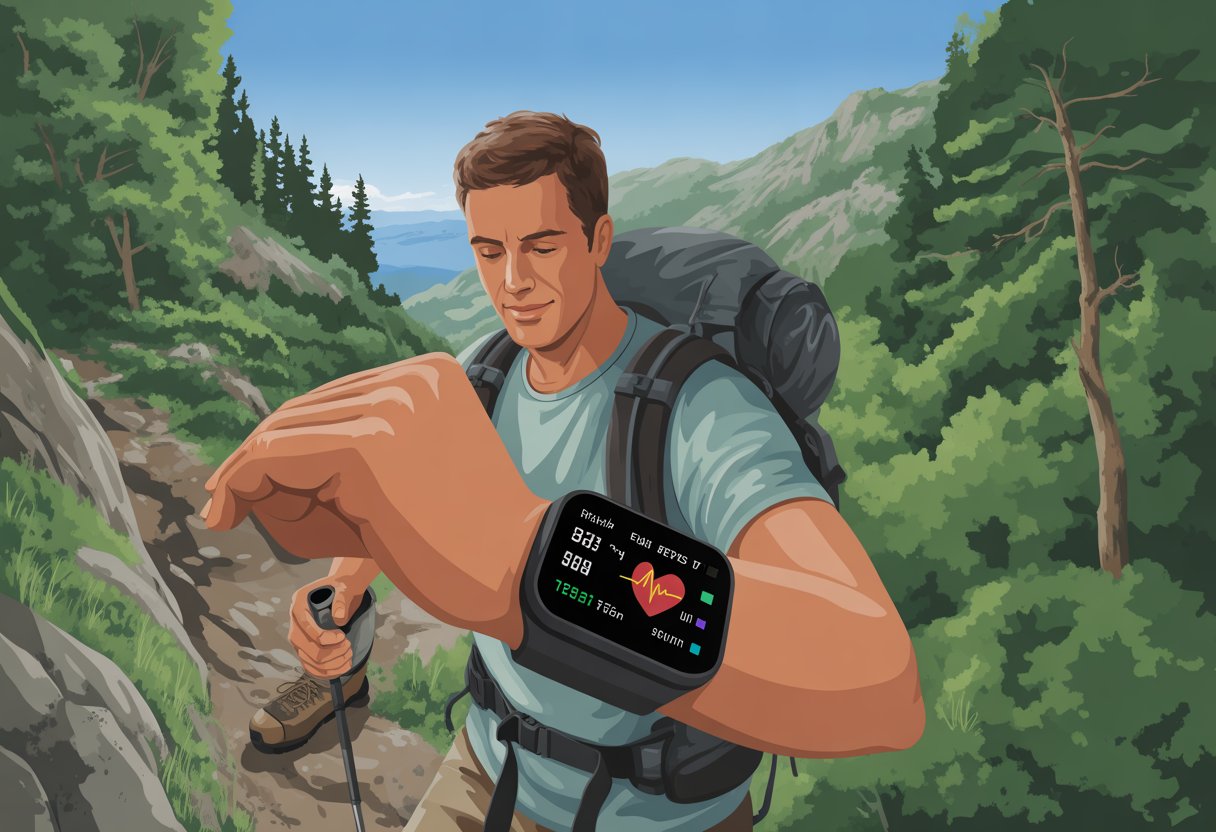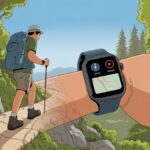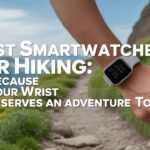Let’s be honest—when we’re out on the trail, most of us don’t want to just guess how far we’ve hiked or how many snacks we’ve earned. Using a fitness tracker while hiking helps us keep tabs on distance, pace, heart rate, and even how many times we’ve cursed the next hill.
With the right tricks, our little wrist gadget does more than just tell time. It turns into a trail buddy who actually remembers the way back.

Ever wonder if you really need all those stats? Honestly, it’s more fun than it sounds.
We get to track our progress, race our old records, and maybe even show off some numbers to friends later. Some models also track elevation gain, GPS routes, and more, so we don’t miss a scenic detour or, more importantly, the next snack stop.
Whether we’re just out for a stroll or trying to summit every hill, there’s a lot we can do with a fitness tracker.
Grab some extra battery life (trust me, you’ll want it), and let’s see how these gadgets can make hiking way more awesome.
Choosing The Right Fitness Tracker For Hiking
Pick the wrong fitness tracker, and your next mountain trip might feel like a guessing game.
It pays to focus on features that make life easier outdoors, compare device types, and see how the big brands stack up for hikers like us.
Essential Features for Outdoor Use
Nobody wants their shiny new gadget to die halfway up the mountain. Battery life matters—a lot.
Some trackers barely make it a day, while others (hello, solar charging) last for weeks. Nobody enjoys staring at a blank screen in the middle of nowhere.
Onboard GPS changes the game. We don’t have to rely on phone service, which, let’s be real, never works when we need it.
An altimeter shows our elevation, so we can brag about every single foot we’ve climbed. Other must-haves?
- Water resistance
- Tough casing
- Bright, easy-to-read display
Offline maps are a lifesaver on remote hikes. These basics keep us safer, help us track our progress, and sometimes even save us from our own sense of direction.
If you want to dig deeper, check out this guide on what to look for in a hiking smartwatch.
Comparing Smartwatches and Handheld GPS Devices
So, do we want a sleek watch or a chunky gadget in our pocket? Smartwatches like the Garmin Instinct or Apple Watch are small, do a bit of everything, and look good, but their screens can be hard to read in sunlight and their battery drains fast with GPS on.
Handheld GPS devices are bigger, a bit old-school, and usually more accurate. They have better maps and last longer, but nobody’s calling them stylish. For most day hikes, a rugged GPS smartwatch works.
If you’re heading out for days or want serious mapping, maybe bring both. Confused? Use this guide to compare fitness trackers, smartwatches, and GPS units.
Review of Popular Brands: Garmin, Apple Watch, Fitbit, Suunto, Amazfit, And Polar
Let’s look at what makes each brand tick, with a little honesty.
| Brand | Key Strengths | Best For |
|---|---|---|
| Garmin | Rugged, long battery, strong GPS | Hikers, backpackers |
| Apple Watch | Great smart features, smooth design | Everyday use, casual hikers |
| Fitbit | Health tracking, easy to use | Beginners, health-focused |
| Suunto | Durable, advanced navigation | Serious hikers, explorers |
| Amazfit | Affordable, good battery life | Budget-friendly, long trips |
| Polar | Heart rate, fitness focus | Runners, cross-training hikers |
From Garmin’s GPS skills to Suunto’s bombproof builds, it comes down to features, price, and how much we want to geek out at the trailhead.
Apple, Fitbit, and Polar are awesome for fitness stats but can lack serious hiking chops. Amazfit is wallet-friendly and light.
Setting Up Your Fitness Tracker For The Trail
Before we hit the trail and rack up the miles, let’s make sure our wrist gadget is ready to go.
Customizing our tracker and syncing it with our favorite tech can save us from getting lost, missing stats, or yelling at the sky when GPS refuses to cooperate.
Syncing With Fitness Apps Like Strava Or Google Maps
First up: let’s get our tracker talking to our phone. Most trackers play nice with fitness apps like Strava or Google Maps.
We usually start by downloading the companion app our device suggests—Garmin Connect, Fitbit, or whatever’s in the box.
Once we connect, it’s time to link our favorite fitness app. In Strava, we hit “Connect a Device” and follow the prompts.
Our gadgets should start sharing data like step counts, heart rate, and hiking routes automatically.
Google Maps sometimes works for navigation, too. When our inner explorer wants a shortcut, syncing lets us send routes straight from phone to watch.
It’s smart to double-check app settings to make sure everything shares nicely.
Updating Maps and Topo Maps
A fitness tracker is only as good as its maps. Before we head out, let’s check for the latest trail and topo maps.
Some trackers include maps, but others need us to update or add new ones. To update, plug our tracker into a computer or connect via Wi-Fi.
Visit the manufacturer’s site or app to hunt for map updates. Garmin users can manage topo maps using Garmin Express or the Explore app.
If we’ve got offline maps, download them before leaving home. Most topo maps show elevation, trails, and points of interest—so we can spot waterfalls before we’re in them.
Check storage space, or we’ll end up playing digital Tetris.
Calibrating Compass, GPS, and Altitude Sensors
Now, let’s calibrate the magic trio: compass, GPS, and altitude sensors. An uncalibrated compass will have us hiking in circles.
For compass calibration, most trackers want us to wave or spin the device in the air. We follow the prompts and try to look casual about it.
For GPS, we step outside and wait for a satellite fix. Sometimes this takes a minute—just enough time to swat a mosquito.
Altitude sensors (barometers) sometimes need manual tweaking. If possible, set the altitude at a known spot, like the trailhead sign.
Well-calibrated sensors give us better data and fewer arguments about who climbed higher.
Let’s get it all set, then hit the trail with confidence (and maybe a little less spinning).
When we use a fitness tracker for hiking, we unlock powerful features that keep us on track and off those “last seen here” posters.
The main tools are GPS, maps, route saving, and sharing our coordinates if things go sideways.
Most fitness trackers with GPS act like our own Siri for the woods. We can see our spot on a tiny map and drop waypoints so we don’t forget where we parked—or hid the snacks.
Setting waypoints is easy: we tap “Save” or “Mark” and the tracker pins the location.
GPS navigation shows us not just where we are, but where we’ve been. If we want to check our elevation gain (or, let’s be honest, loss), stats like distance, pace, and elevation are right there.
When we get turned around, those waypoints act like digital breadcrumbs. More details are in REI’s guide to using a fitness watch for trail navigation.
Following Preloaded And Custom Routes
It’s just smarter to follow preloaded or custom routes. Wandering aimlessly? That’s so last century.
Many trackers let us upload GPX files or use preloaded maps. We can plan our hike online, download the route, and our tracker gives us turn-by-turn directions—just like a car GPS, but with more trees.
Some trackers show trail maps, elevation graphs, and even alert us if we stray too far. This keeps us on course and out of “oops, wrong valley” territory.
We can customize the hike, set detours, and bookmark cool spots right from our wrist. It’s handy for proving we meant to take that “shortcut.”
Utilizing Coordinates and Satellite Messengers
Coordinates help us get found, not just lost. Our tracker usually tells us our latitude and longitude, so if we need help—or want to brag—we can send the numbers in a snap.
A lot of hikers pair trackers with satellite messengers. These gadgets send our coordinates to emergency services when cell service disappears.
It’s nice knowing someone could find us with just a set of numbers. A satellite messenger works even when our phone’s given up.
This is good to know when using GPS and satellite tools for hiking.
Essential Hiking Metrics And How To Track Them
On the trail, our fitness tracker becomes our assistant—minus the bad jokes.
It tells us how far we’ve gone, how fast we’re moving, how high we’ve climbed, and if our heart is pounding from excitement or just that last killer hill.
Step Count, Mileage, And Pace
If you ever want to prove to your friends that you trudged uphill both ways, counting steps is a sneaky way to back up your story.
Fitness trackers use a pedometer to tally up your steps all day. Every step gets logged, and the tracker estimates distance using your stride—even if your stride shrinks embarrassingly on those steep climbs.
Mileage helps you plan water stops and snack breaks. The built-in GPS is usually more reliable, especially if you wander off the main trail.
You can check your total mileage in the app or just glance at your wrist.
Pace shows how fast you’re moving over a certain distance. If your pace slows down, maybe it’s time for a snack, a little break, or just a reminder that nobody’s chasing you.
A lot of good hiking watches track and display step count, distance, and pace. You can compare them in detail at best hiking watches.
Monitoring Speed, Elevation, And Altitude
The next time you face a hill that looks like Mount Everest’s little sibling, check your speed and elevation gain.
GPS fitness trackers will show your current speed, average speed, and even those sudden sprints—like when you spot a bear (hopefully not, though).
Barometric sensors and GPS data help track elevation and altitude. They show how high you’ve climbed, your total vertical gain, and your current altitude above sea level.
It’s a techy way to brag about summiting that peak—just flash your stats and let the numbers do the talking.
If you want more about how these features work, check out tips on using GPS watches for hiking.
Measuring Calories Burned And Heart Rate
Keeping track of calories burned gives you a solid excuse to eat more trail mix—science, right?
Fitness trackers estimate calories burned based on your steps, effort, age, weight, and sometimes your heart rate.
If your device tracks heart rate, it’ll show how hard your heart works on steep climbs, tricky descents, or when you finally find that perfect view.
Watching your heart rate can tell you if it’s time to slow down, or if you can push a little harder. A steady heart rate on the uphill usually means you’re in hiking shape—or maybe just really good at faking it.
You’ll find detailed heart rate and calorie tracking in most top GPS hiking watches, like in this review of top GPS watches for hiking.
Maximizing Battery Life On The Trail
Nothing kills an outdoor adventure faster than your fitness tracker dying halfway through the hike. You want that battery to last, so you don’t have to fake going “off-grid” when really you just ran out of juice.
Battery-Saving Tips For Longer Hikes
We all want our tracker’s battery to outlast our legs. First, dig into those battery-saving settings.
Lower the screen brightness—think of it like hiding from bugs at night. If there’s a backlight, turn it off or set it to only come on when you need it.
Try Airplane Mode to save power, especially if you don’t care about Aunt Sarah’s cat memes while you’re hiking. Turning off Bluetooth and Wi-Fi stops your device from constantly searching for signals.
GPS drains battery fast. Most trackers let you adjust how often they check your location. Switching from a 1-second update to a 5- or 60-second interval can help stretch battery life, but you might lose a bit of accuracy.
If your tracker has a power-saving mode like UltraTrac on some Garmin models, use it to squeeze out more hours per charge.
And really, don’t spend forever scrolling the map screen. Loading maps over and over will drain your battery before you even get to the good part of the trail.
For more practical battery tips, check out Trackpath and Garmin Forums.
Using Power Banks And Extra Batteries
Even the best power-saving tricks can only go so far—sometimes you just need backup: power banks and spare batteries.
A small, lightweight power bank can give your fitness tracker a quick boost on longer hikes. Look for at least 5,000mAh so you get a couple of charges without adding much weight.
If your tracker uses swappable batteries (rare, but they exist!), bring extras. Just try not to leave them in the glovebox.
Keep power banks and cables dry by stashing them in a zippered pouch or sealable bag. Nothing’s worse than pulling out your emergency charger and finding it soaked from a surprise rainstorm or a misjudged creek crossing.
With smart power saving and a trusty backup charger, you might just finish your hike with more battery left than blisters.
Integrating With Other Outdoor Tech Gadgets
A fitness tracker does way more than just count steps—it can turn you into a bit of a gadget nerd (in a good way). Sync it with your phone, apps, or even your friend’s drone, and suddenly you’ve got data, safety, and entertainment all in one hike.
Connecting With Smartphones And Apps
When you pair your tracker with a smartphone app, it’s like getting a hiking coach who never runs out of breath.
Most fitness trackers connect with apps like Strava, Komoot, or Apple Health. You get real-time stats, maps, and sometimes a digital high-five when you hit your goals.
You’ll see more than just heart rate and steps. Check weather alerts, download offline trail maps, and get notifications—even halfway up a mountain, trying not to lose your shoe in the mud.
Some apps track your exact route using GPS from your tracker, so you don’t end up on a “surprise adventure” into the wild. For more info, check out these hiking and backpacking tech tips.
Syncing With Drones And Cameras
Syncing tracker data with drones and cameras sounds wild, but it’s easier than you’d think.
Some fitness trackers and smartwatches can send activity stats or waypoints right to a drone’s app. Imagine tagging special moments with your heart rate, or using GPS logs to direct a drone to film that spot where you finally pulled off a victory dance.
Action cameras like GoPros often have their own apps that can grab stats from your tracker. You can overlay your speed, altitude, or trek duration onto your videos.
Suddenly, your hiking highlight reel looks like a documentary—just with more slips and out-of-breath commentary. For more on gadgets that play nice together, check out these wearable tech tips for hikers.
Safety And Emergency Features
Getting lost in the woods? Not as fun as it sounds. Luckily, fitness trackers and smartwatches come packed with tools to help you stay safe—and avoid starring in your own survival show.
SOS And Live Tracking
Many fitness trackers have SOS and live tracking features. You can share your real-time location with friends or family, so they won’t panic if you’re just taking your time.
Devices like Garmin watches make it easy to turn on Incident Detection. If you take a hard fall or stop moving, your location goes straight to your emergency contacts.
Some models have loud sirens to get attention, and a few watches offer fall detection. Setting these up usually just takes a few taps in the settings—or, let’s be honest, a few minutes of head-scratching if you skip the instructions.
Some satellite messengers can send SOS messages from anywhere, even if you’re way out where your phone signal is just a rumor.
Here’s what you’ll want to look for:
- SOS button or alert
- Fall detection
- Live location sharing
- Loud audible alarm
Using Compass And GPS For Rescue
A built-in compass can help you get your bearings when trail markers disappear. Plenty of fitness trackers also have GPS, so you’ll know exactly where you are—unless you buried your tracker under a pile of snacks.
GPS features let you check your coordinates, retrace your steps, or quickly share your position if you need help. Advanced units and satellite messengers let you send your GPS location as part of an SOS, which is handy when the only thing nearby is a curious squirrel.
Carry your tracker where it can see the sky—not at the bottom of your pack or in a pocket stuffed with granola bars, as GPS experts recommend.
A compass and GPS combo helps you:
- Stay on track
- Find your way back to the starting point
- Help rescuers reach you faster if things go sideways
Making The Most Of Your Hiking Experience
Who decided a fitness tracker is just for counting steps? With a smartwatch on your wrist, you can capture memories, compete with friends, and maybe even remember to look up and enjoy the view.
Recording Your Adventures For Social Sharing
If you didn’t post it online, did the hike even happen? Your fitness tracker does more than count miles—it records your route, elevation, and sometimes even heart rate.
Snap a sweaty selfie at the summit, then upload the stats for your friends to marvel at—or roll their eyes.
Most fitness apps let you save hikes and share cool maps showing your route. Want to add commentary or tag friends in that forest loop? A lot of smartwatches let you do that, too.
Just don’t accidentally share a hike that started and ended at the snack bar.
Adding stats like steps, distance, and altitude to your photos or posts helps you relive the adventure—and maybe brag a little—without boring everyone with spreadsheets. Posting achievements online can push you to set bigger hiking goals. If your hike didn’t include a fun boast to your group chat, did you really leave the couch?
Comparing Hiking Metrics With Running, Swimming, Or Triathlon Modes
Hiking’s awesome, but sometimes you want to see how it stacks up against your other workouts. Most fitness trackers have modes for running, swimming, or even triathlons.
Switching between them lets you compare calories burned, pace, and effort with just a couple taps.
Here’s a quick look at how these activities usually compare:
| Activity | Typical Metrics Tracked | Average Calories/Hour* |
|---|---|---|
| Hiking | Distance, Elevation gain, Heart rate | 430 – 500 |
| Running | Speed, Cadence, Heart rate | 500 – 700 |
| Swimming | Laps, Stroke, Pace | 400 – 600 |
| Triathlon | All the above + Transitions | 600 – 900 |
*All averages are just estimates. Your numbers might be way off, especially if you get lost and double your distance!
Switching modes is simple on most devices, so you don’t have to stick with “hiking” if you want to jog, paddle, or play Olympic-level “where’s the trail?” Your smartwatch lets you see how hiking compares with your other adventures—and gives you more ways to show off.
Observing Nature Without Getting Too Distracted By Notifications
Hiking’s supposed to help us unplug, not just hunt for a good signal. Those fitness trackers really love to ping us, don’t they? But every time we pause to check a notification, we might miss a deer, a rare flower, or maybe even that squirrel plotting world domination.
So, how can we use a smartwatch without turning into screen zombies?
- Set “Do Not Disturb” or pick a hiking mode
- Only allow the must-have notifications (do we really need every email?)
- Switch to vibration instead of those loud alerts
Tweak your settings so you can stay connected if you need to, but actually soak up all the sights and sounds out there. It’s way better to come back with memories of nature than just a log of spam emails and chat gifs.
Troubleshooting And Maintenance Tips
Taking care of your fitness tracker matters just as much as planning your route or grabbing snacks. If our tech gives up on us during the hike, there goes our chance to brag about our steps later.
Dealing With GPS And Sensor Issues
Nothing kills the mood faster than a GPS meltdown when you’re deep in the woods and suddenly not sure if you’re heading for the summit or just chasing another squirrel. Before heading out, make sure your tracker’s battery is fully charged. Low power can mess with location accuracy and make your altitude look totally made up.
If your device loses signal in dense trees or narrow canyons, don’t panic. Sometimes, if you give the tracker a couple of minutes under open sky, it’ll lock onto satellites again. Try turning the GPS off and back on too. Regular software updates also help your device talk to satellites like they’re old friends instead of strangers.
If your sensors (like heart rate or altimeter) start acting weird or freeze, try a quick restart. If that doesn’t work, unstrap the tracker, wipe off sweat, dirt, or whatever mysterious gunk it’s picked up, and give it another shot. Sometimes, just turning it off and on again is all it takes to bring it back to life.
Cleaning And Protecting Your Device For Outdoor Adventures
Mother Nature’s gorgeous, sure, but she doesn’t really care about your fitness tracker. It’s a pain when your favorite gadget gives up because it inhaled a bunch of trail dust.
After every hike, just grab a soft, damp cloth and wipe your tracker down. If you spot some stubborn grime, a toothbrush with a drop of mild soap usually does the trick.
Don’t dunk the device unless you know it can handle a swim—most can’t, even if they’ve survived a surprise rainstorm or two.
A screen protector or a rugged case can save your tracker from scratches and nasty bumps, especially if you’re bushwhacking or, let’s be honest, tripping over rocks.
Seal up all ports and buttons before you go splashing through creeks. Nobody wants to learn the hard way that water and electronics just don’t mix.
Keep your tracker somewhere cool and dry when you’re not using it. Leaving it to bake in a hot car? That’s just asking for melted plastic and a useless battery.
If you stick with regular cleaning and a bit of extra protection, your device will be ready for every hike—and all those step-count competitions you pretend not to care about.
- Why is my fitness tracker not pairing with Apple Health? Troubleshooting for Technologically Cursed Mortals - December 22, 2025
- Why is my fitness tracker not updating firmware? Tech Tantrums and Update Woes Explained - December 21, 2025
- Why is the Sound Quality on My Bluetooth Headphones Poor? It’s Not Just Bad Music Taste! - December 21, 2025






